The Lanford Wilson Project: “The Mound Builders” & “Sympathetic Magic”
A chance to reexamine two of Wilson’s major plays from a new vantage point focusing deserved attention on works that comment on each other.
[avatar user=”Victor Gluck” size=”96″ align=”left”] Victor Gluck, Editor-in-Chief[/avatar]

Kelsey Claire, Steve Carlsen, Tamra Paselk, Carson Alexander and Jeffrey C. Wolf in a scene from Open Circle Play Factory’s revival of Lanford Wilson’s “The Mound Builders” at Theatre Row (Photo credit: Maria Baranova)
Since Pulitzer Prize winning playwright Lanford Wilson passed away in 2011, he seems to have gone into eclipse except for a 2019 Broadway revival of his four-character drama, Burn This. Now a new theater company, Open Circle Play Factory, has been formed to reassess his work and those of other writers from the Circle Repertory Company which he helped found. Their inaugural endeavor is aptly called “The Lanford Wilson Project” including revivals of his The Mound Builders and Sympathetic Magic, two plays which were written 22 years apart but appear to have been conceived as companion plays with a great many things in common. As such they make fascinating viewing back to back. However, each is an entirely separate story and they do not need to be seen together.
It appears that the later play was modeled on the earlier one though it may not have been noticed back in 1997 when Sympathetic Magic had its New York premiere. Both plays deal with discoveries by scientists: archeologists in The Mound Builders looking in the earth and astronomers in Sympathetic Magic examining the sky. The themes of both are about ethics in science, in The Mound Builders science versus commerce, and in Sympathetic Magic, science versus fame. Both include a pair of brothers and sisters, and one parent of each is of vital importance, though not seen in both plays. A woman artist appears in each: a famous blocked novelist in The Mound Builders and a quickly rising sculptress in Sympathetic Magic. Each drama has a newly announced pregnancy that is paralleled with the new scientific discovery. Both are ensemble plays dealing with a tightly knit group of people affiliated with a university department. In each a project ends disastrously, as well as a relationship breaks up for differing reasons. The academic world intrudes on both plots as the scientists are professors at their respective institutions.

Alexander Spears, Taylor Lynn Carter and Matthew Bechtold in a scene from Open Circle Play Factory’s revival of Lanford Wilson’s “Sympathetic Magic” at Theatre Row (Photo credit: Maria Baranova)
While both productions use different casts, the production team is the same for both and performed on the same set. The Mound Builders (1975) takes place in two locales: the office of Professor August Howe (Jeffrey C. Wolf) at the University of Illinois in Urbana, and the archeological dig the previous summer in the fictional Blue Shoals, Illinois. Howe is dictating to his secretary about the disastrous events of the dig in its third summer racing against time and a rising lake. Howe and his associate Dr. Dan Loggins (Carson Alexander) along with a group of unseen students are working to uncover Pre-Columbian artifacts of the Mississippian peoples who built burial mounds which dot the middle of America.
They are working on land owned by the unseen Jasker, Senior and his son Chad (Steve Carlsen), a hanger-on at the dig, who is looking forward to the end of the summer when he has been informed that an interstate will be built, making his father’s lakefront property worth a fortune. Along with the scientists are their wives Cynthia Howe (Tamra Paselk), a photographer working on the dig, and Dr. Jean Loggins (Kelsey Claire), Dan’s pregnant wife, a gynecologist, who has had trouble bringing a child to term. The group is completed by Howe’s unstable sister, the novelist D.K. (Delia) Eriksen (Angela Atwood) who has been dumped on them after a month in rehab drying out from her latest escapades, and his 11-year-old daughter Kirsten (Stella Marcus).
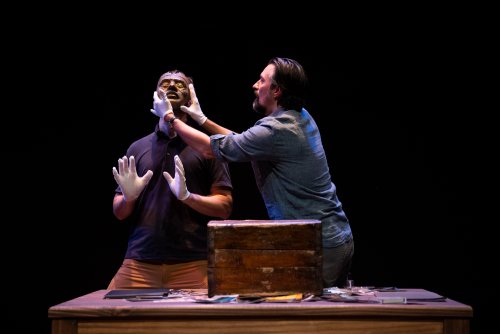
Carson Alexander and Jeffrey C. Wolf in a scene from Open Circle Play Factory’s revival of Lanford Wilson’s “The Mound Builders” at Theatre Row (Photo credit: Maria Baranova)
When a truly remarkable discovery is made, the first of its kind for the Mississippian people, the scientists are ecstatic and the chairman of the department books a flight to see for himself. This creates a conflict with Chad Jasker who cannot wait for the dig to end. The tragic consequences are quite shocking. While the play has a tightly constructed second act, the first act is diffuse and rambling, giving no clue as to where it is going, other than Dr. Howe’s cryptic opening remarks. The script requires slide projections to show us the dig but the production has chosen to skip them in favor of small photographs we cannot see. For the purpose of quick transitions between scenes and time periods, director Mac McCarty has used only a table, chairs and a divan, but without the slides the play has no visual atmosphere. Andrew Oppenheim’s sound design does not go as far as Wilson requests so that we don’t hear the bulldozers by day or the country sounds by night.
Though Wilson’s plays may be categorized as talky, McCarty has directed the first act for the actors to talk at so frenetic a pace that the audience is exhausted by the intermission. One assumes that the cast is too. The second act which is much more dramatic is played at a more conversational tone but the damage has been done. The acting is uneven, though all are engrossing. Most interesting are Carlsen’s hyped-up Jasker, Atwood’s quirky D.K. Eriksen, and Alexander’s animated Dr. Dan Loggins. Wolf’s Professor Howe is an authority figure but rather bland as is Paselk as his wife. As Dan’s pregnant wife Jean, Claire is suitably emotional but unfortunately one-dimensional. Marcus in the role of the daughter (which was eliminated in a revised version of the play) is given hardly anything to do.
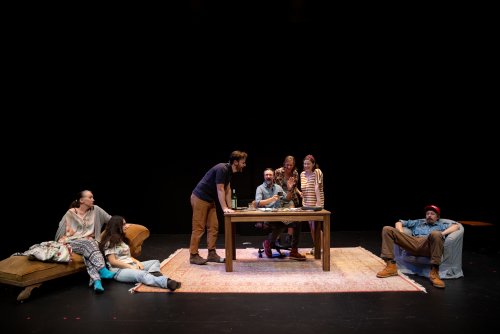
The company of Open Circle Play Factory’s revival of Lanford Wilson’s “The Mound Builders” at Theatre Row (Photo credit: Maria Baranova)
Sympathetic Magic is a more complex, mature play with more characters but ultimately less satisfying in its ending. It follows a group of creative people working on their various projects in and around San Francisco at the height of the AIDS epidemic: two astronomers, an artist, a choir director, an anthropologist, a university department chairman, and an Episcopalian minister who wants to found an AIDS hospice. We follow five sets of characters whose lives and scenes overlap until they all come together in a climactic birthday dinner near the end of the play. One of the problems with McCarty’s production is that the author calls for indication of various locations in and around San Francisco but the use of nothing but a table and chairs does not create any atmosphere, particularly missing in the telescope observatory scene.
The title refers to a theory stated by anthropologist James Frazer in The Golden Baugh, his study of comparative religion and mythology. Frazer named a phenomenon he observed as “sympathetic magic”: it is a superstition ritual, that when ancient peoples wanted rain they would make the sound of rain. According to Dr. Liz Barnard (Katherine King), a famous anthropologist back from Africa and applying her knowledge to gangs in the Bay Area: “Magic doesn’t prepare us for these little speed bumps of real life. They pretend it’s raining, act out rain, believing it will cause it to rain… and we act out good partnerships, or marriages families or life – believing it will cause a real partnership or worthwhile life to happen.” Unfortunately, except for depicting a series of relationship breakups this does not help explain or unlock Wilson’s play.
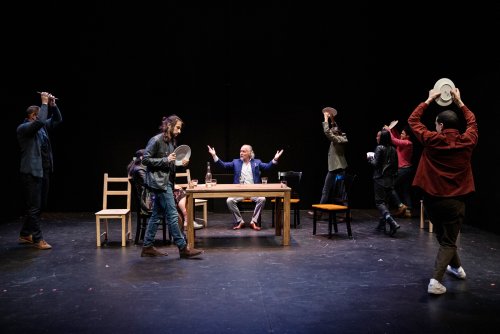
The company of Open Circle Play Factory’s revival of Lanford Wilson’s “Sympathetic Magic” at Theatre Row (Photo credit: Maria Baranova)
At the center of the play is a new discovery by astronomer/professors Ian Anderson, AKA Andy (Mitch Lerner) and his associate Mickey Picco (Alexander Spears) which may just change what is known of quantum physics. Circling around this is the revelation that Andy’s girlfriend the sculptress Barbara De Biers (Taylor Lynn Carter), dealing with a critical drubbing of her new show which is proving to be a commercial success, is pregnant even though both she and Andy have taken every precaution as they don’t want children at this stage in their careers.
Barbara’s half-brother, Father Don Walker (Matthew Bechtold), a gay clerict who has recently decided to remain celibate, has been told by his board he cannot use their empty barn to create an AIDS hospice. His former lover Pauly Scott (Pethio Dav) is attempting to create a new choir having lost his previous one to the AIDS epidemic. Dr. Barnard, the mother of both Barbara and Don, who is going blind (which may be a sign of a more virulent illness) is dictating her autobiography to Susan Olmsted (Athena Torres), a law intern taking a break from her studies. While Mickey is suffering from the sudden breakup with his girlfriend who has moved out taking the television but not the VCR, Andy’s chairman is attempting to make a name for himself based on Andy and Mickey’s research. When one of these relationships goes smash, it affects all of the other characters.
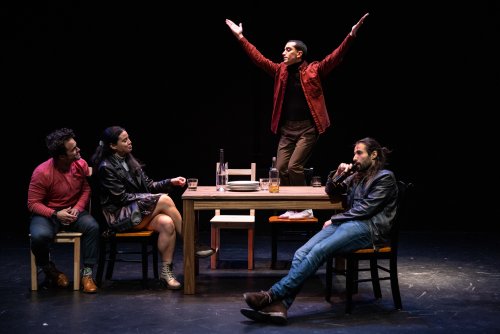
Alexander Spears, Athena Torres, Pethio Dav and Mitch Lerner in a scene from Open Circle Play Factory’s revival of Lanford Wilson’s “Sympathetic Magic” at Theatre Row (Photo credit: Maria Baranova)
Wilson’s play is extremely cinematic as we follow the interactions of these eight people but ultimately the theme of sympathetic magic seems to be lost along the way. Using an alternate cast than in The Mound Builders, McCarty’s direction is uneven though the play at all times holds our attention even when we have no idea where it is going. Both King’s Liz and Lerner’s Andy are allowed to rant and rave at various times which diminishes their authority. McCarty has rearranged the final sequence of scenes even reassigning a speech to another character, unless there is a revised version different from the published one.
It is difficult to know who the central character is in this ensemble piece with each of them jockeying for prominence in succeeding scenes. Lerner is forceful as the charismatic Andy although he seems more brash than charming. As his live-in girlfriend Barbara, Carter is rather low-key but this makes her all the more level-headed and sober. Spears has not yet found his way into the role of astronomer Mickey Picco, while Torres as Susan with whom he has many scenes is witty and acerbic. As the popular Pauly, Dav is vivacious and ebullient. Bechtold as Father Don is rather too remote and reticent, while King as his mother Liz is usually overbearing and imperious. On the other hand, W. Philip Rafferty as Professor Carl Conklin White, the head the astronomy department, brings a surprising element of the sinister and insidious. Joe D’Emilio’s rather dark lighting does little to differentiate the many locations.
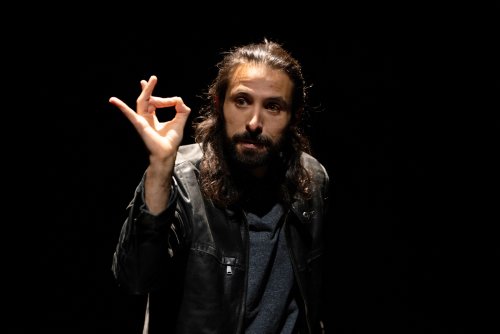
Mitch Lerner as astronomer Ian Anderson (Andy) in a scene from Open Circle Play Factory’s revival of Lanford Wilson’s “Sympathetic Magic” at Theatre Row (Photo credit: Maria Baranova)
The Lanford Wilson Project by Open Circle Play Factory is an ambitious and noteworthy theatrical event. It also gives us a chance to reexamine two of Wilson’s major plays from a new vantage point focusing deserved attention on works that comment on each other. Seeing The Mound Builders and Sympathetic Magic together offers a renewed insight into the work of this major American playwright. However, either one is a fine introduction into Wilson’s body of work.
The Lanford Wilson Project: The Mound Builders & Sympathetic Magic (in rotating repertory, through December 19, 2021)
Theatre Five at Theatre Row, 410 W. 42nd Street, in Manhattan
For tickets, visit https://bfany.org/theatre-row/shows/the-lanford-wilson-project-part-one-the-mound-builders/
https://bfany.org/theatre-row/shows/the-lanford-wilson-project-part-two-sympathetic-magic/
Running time: each play runs two hours with one intermission






Lanford Wilson would have been horrified and depressed by these two productions, which I saw this past week. I worked with the playwright in the early days: La Mama, Balm in Gilead, Circle Rep, etc. Your reviews are accurate, but too kind. Much of the fault for these disastrous productions lies with the insensitivity of the director. Lighting, sets, sound,and costumes were cut to the bone. After viewing these limp and sad performances, I left the Theatre horrified and depressed.
These two productions did not do the great Landford Wilson brilliant work any justice.
The acting was amateur with the exception of maybe 2 or 3 performers and the sets were cold and stark and depressing.
The worst part was the direction which was all over the place.
The performers spoke too rapidly and the productions felt rushed and lacked emotional depth.
I was greatly disappointed.
You nailed it when you said the audience felt exhausted by intermission by the rapid dialog and superficial performances.
I suppose the actors did what they could with the lousy directions they were given
Which were a absolute mess.
Most of the reviews have not been kind and I can see why.
Just a total dissapointment in every aspect as a Lanford Wilson fan.
Sloppy, clumsy,self indulgent and overall bad directing.
Mediocre and extremely rushed paced acting.
Waste of time.
Glad I clicked on the entire article and review.
They only quoted one line from this interview that was positive and didn’t post the entire review as a whole.
I was going to it check out ,but now I think I’ll save my money after reading the complete review and not one headline.